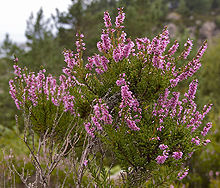Calluna vulgaris
| Calluna | |
|---|---|
 |
|
| Flowering Calluna vulgaris | |
| Scientific classification | |
| Kingdom: | Plantae |
| Clade: | Angiosperms |
| Clade: | Eudicots |
| Clade: | Asterids |
| Order: | Ericales |
| Family: | Ericaceae |
| Genus: |
Calluna Salisb. |
| Species: | C. vulgaris |
| Binomial name | |
|
Calluna vulgaris (L.) Hull |
|
Calluna vulgaris (known as common heather, ling, or simply heather) is the sole species in the genus Calluna in the [flowering plant]] family Ericaceae. It is a low-growing perennial shrub growing to 20 to 50 centimetres (7.9 to 19.7 in) tall, or rarely to 1 metre (39 in) and taller, and is found widely in Europe and Asia Minor on acidic soils in open sunny situations and in moderate shade. It is the dominant plant in most heathland and moorland in Europe, and in some bog vegetation and acidic pine and oak woodland. It is tolerant of grazing and regenerates following occasional burning, and is often managed in nature reserves and grouse moors by sheep or cattle grazing, and also by light burning.
Calluna was separated from the closely related genus Erica by Richard Anthony Salisbury, who devised the generic name Calluna probably from the Greek Kallyno (καλλύνω), "beautify, sweep clean", in reference to its traditional use in besoms. The specific epithet vulgaris is Latin for 'common'. Calluna is differentiated from Erica by its corolla and calyx each being in four parts instead of five.
Calluna has small scale-leaves (less than 2–3 mm long) borne in opposite and decussate pairs, whereas those of Erica are generally larger and in whorls of 3-4, sometimes 5. The flowers emerge in late summer; in wild plants these are normally mauve, but white-flowered plants also occur occasionally. They are terminal in racemes with sepal-like bracts at the base with a superior ovary, the fruit a capsule. Unlike Erica, Calluna sometimes sports double flowers. Calluna is sometimes referred to as Summer (or Autumn) heather to distinguish it from winter or spring flowering species of Erica.
...
Wikipedia
